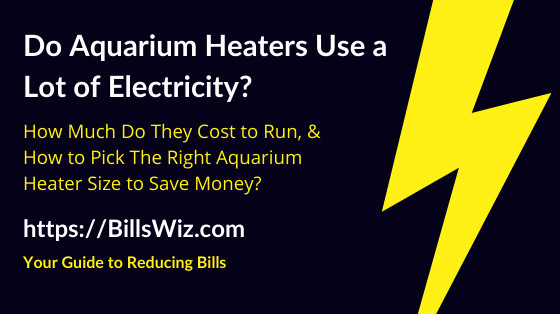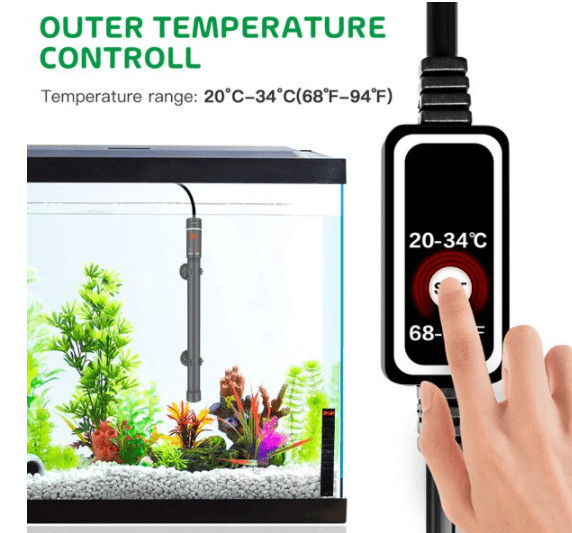Do aquarium heaters use a lot of electricity and significantly increase your bill?
How different are they from water heaters that consume lots of energy to run?
And how to pick the right aquarium heater in order to maintain a healthy and safe environment for the fish, and not waste money on electricity bill?
These questions and more, I will be answering now, in order to help you make the right decision.
Without further ado, let’s begin!
Do Aquarium Heaters Use a Lot of Electricity?
Aquarium heaters use a low-to-medium amount of electricity, which varies depending on their power rating, the tank size, the set temperature, and the room temperature.
In extreme cases with big fish tanks in relatively cool rooms, the aquarium heaters might consume a lot of electricity in order to maintain the proper water temperature.
But generally speaking, aquarium heaters do not consume a lot of energy like water heaters with tanks for example, simply because aquarium heaters need to raise the water temperature only a few degrees that are comfortable to the fish, unlike water heaters with tanks.
Recommended for US Homeowners:
Related: Worried about Your Next Electricity Bill? Here’s How 1,000’s of US Homeowners Get Almost $0 Bills!
Related: Are You Missing Out on This Tax Credit Opportunity? (And 3 Other Benefits!)
How Much Electricity Does an Aquarium Heater Use?
An aquarium heater uses anywhere between 25-500 watts of electric power in order to run, and there are some manufacturers that make bigger heaters of up to 800W rating.
As mentioned above, the actual value depends on the actual tank size, and the difference between the room’s temperature and the desired water temperature, which means two tanks of the same size might require different heater sizes depending on the temperature of the rooms they are in.
But on average, each gallon of the size requires between 3-5 watts of a heater.
Here’s a quick aquarium heater sizing chart from The Spruce Pets showing the needed heater size for each fish tank along with the difference between the room temperature and the desired water temperature for guidance.
(Source)
Note that this is the wattage that an aquarium heater uses in order to run.
To find the amount of electric energy the aquarium heater uses, which is what the electricity meter records and what you pay for, you need to know the size of the heater you will install, and how long (in hours) it works every day.
You might ask now:
Does the aquarium heater not work all the time?
In most cases, no, the aquarium heater will not have to work all the time 24/7.
You still need to keep it on all the time.
But the heater will often work until it heats up the water to the desired temperature, and then the internal thermostat will disconnect the circuit and will keep it off for few minutes, until the temperature drops again for few degrees, and then the thermostat will bring the power back on, and so on.
How long is the on-period and the off-period depends on the tank’s ability to maintain the water temperature close to the set temperature, which usually depends on the temperature of the room.
If the room’s temperature is too low, then the water would lose the heat relatively quickly, and the off-period would be short compared to the on-period of the aquarium heater, which would make it consume more electricity.
How Much Energy Does an Aquarium Heater Use?
Assuming that the heater will work on a 50%-50% on/off duty cycle, meaning that it works for 15 minutes, then shuts down for 15 minutes, and assuming the difference in temperature of 18 F or 10 C degrees, here’s how to calculate much energy it would consume:
Energy consumed per day = Power rating in kilowatts (rating in watts/1000) X 24 hours/day X 0.5 (50-50 duty cycle)
Energy consumed per month = Energy consumed per day X 30 days/month
For example, for the small-size 10-gallon aquarium, the heater would be sized at 75 watts.
Energy used per day = 75/1000 X24 X0.5 = 0.9 kWh/day
Energy used per month = 0.9 X 30 = 27 kWh/month
For the medium-size 50-gallon aquarium, the heater size would be, on average, 200 watts.
Energy used per day = 200/1000 X24 X0.5 = 2.4 kWh/day
Energy used per month = 2.4 X 30 = 72 kWh/month
And for a larger 75-gallon aquarium, the heater size would on average be 300 watts.
Energy used per day = 300/1000 X24 X0.5 = 3.6 kWh/day
Energy used per month = 3.6 X 30 = 108 kWh/month
That’s how much electric energy aquarium heaters use per day and per month, on average.
Remember that these are just estimates, and the actual consumption would be different based on the actual tank size you have, the actual heater size, the difference between the room’s temperature and the desired water temperature, and on the tank’s ability to retain heat.
How Much Does an Aquarium Heater Cost to Run?
On average, an aquarium heater costs between $4 to $15 a month in order to run, based on the average electricity price of around 14 cents/kWh, and based on the estimated average heater sizes fr small, medium, and large aquariums and on the duty cycle of 50% on – 50% off.
To find the actual cost running cost, you need to find the monthly energy consumption of the heater in kWh, and multiply it by the electricity rate in cents/kWh.
For example, the 75W heater for the 10-gallon aquarium, which runs around 50% of the time, consumes around 0.9 kWh per day and around 27 kWh per month.
With the average rate of 14 cents/kWh ($0.14/kWh), the cost to run this aquarium heater would be:
27 kWh/month X $0.14/kWh = $3.78/month.
And for the 200W heater for the 50-gallon aquarium, which consumes around 2.4 kWh/day and 72 kWh/month, the running cost would be:
72 X $0.14 = $10.08/month
And for the 300W heater for the 75-gallon aquarium, which consumes around 3.6 kWh/day and around 108 kWh/month, the running cost would be:
108 X $0.14 = $15.12/month.
Note that these are estimates based on the average heater size, 50-50 on-off cycle, and average energy rate of 14 cents/kWh.
The actual cost of running an aquarium might differ based on the actual aquarium and heater sizes, the on-off cycle duration, and the energy price as different companies charge different energy prices.
For example, in California and Connecticut, where the prices are higher, you may pay 50% more than the estimates above with the same estimated consumption in kWh, while in Idaho, Missouri and Nebraska, you may pay 25-30% less than the estimated costs above with the same energy consumption.
Tips to Keep Aquarium Heater’s Cost at Minimum
Here are some tips that can help you keep the aquarium heater running efficiently and lower its running costs:
- Choose the right size of the heater based on the tank size and the difference between the room’s temperature and the desired water temperature that might change depending on the fish type you have.
- For larger aquarium tanks, you may install two medium-sized heaters distant from each other, instead of one big heater, which ensures a more even heat distribution.
- Try to install the tank away from the window and from air chills that make it lose heat faster and require the heater to work harder and for longer hours a day.
- The aquarium heater should come with an internal thermostat that can be set to internally turn on and off in order to maintain the water within a small range of temperature that is healthy for the fish.
Conclusion
An aquarium can be a nice addition to the living space, and the heater might be necessary in order to keep the fish healthy and alive.
On average, aquarium heaters do not use a lot of electricity, especially when compared to big contributors to the electric bill like water heater, or hot tubs that use lo ts of electricity, as those need to raise the water temperature significantly, while the aquarium heater needs only to left it few degrees.
Choose the right heater size based on the fish type and the tank size, and go for two heaters with big tanks in order to maintain a balanced distribution of heat across the tank.
I hope that was helpful!
If you still have other questions on aquarium heaters and their energy usage and running costs, please, let me know in the comments’ section below, and I will do my best to help you out





